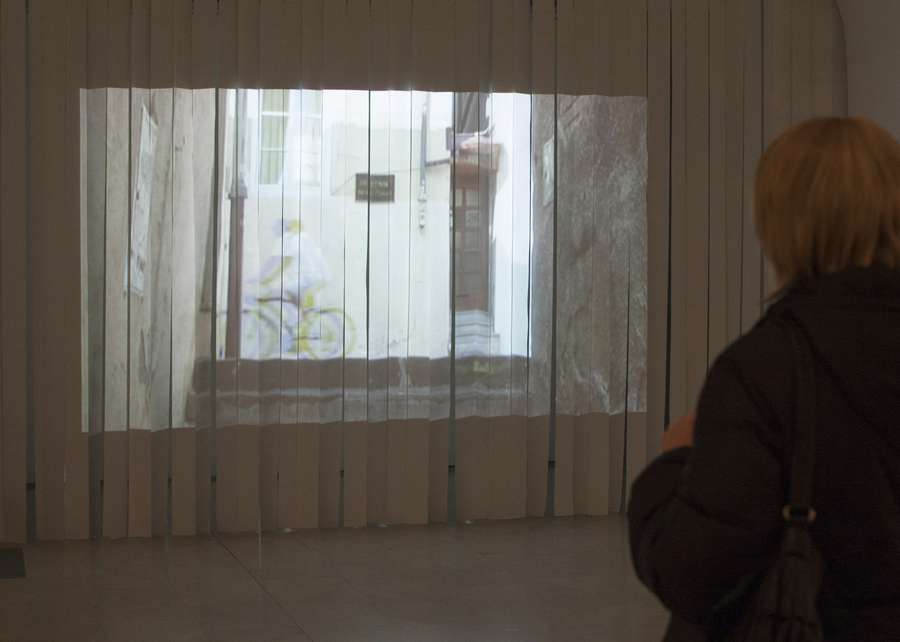Neca Falk: Journey into the Void
What the works in this solo exhibition by Neca Falk have in common on the level of ideas is perhaps best conveyed by its very title. Journey into the Void thus primarily stands for a journey into the medium of painting which, in the context of an expanded field of modern artistic practices in Slovenia, has nearly been forgotten and, at the same time, a journey into largely anonymous and/or abstract non-events pertaining to elusive and fluid digital (photographic/video) images.
One part of this journey into the void does indeed somehow point to Zabel’s interpretation of a journey into the space of an image which has given up its representational function (i.e. in terms of the modernist position of an image), into the terminal horizon of an image, a thing "which exists past our conceptual definitions and symbolisations, an entity which has ceased to be our ‘object’, is beyond concepts and therefore ‘void’" (Zabel 1997:34). However, as pointed out by Zabel, this "conception of a picture as a fluid process of creation and circulation in ‘a space between’" (ibid.) must not be confused with the space inviting a free, arbitrary interpretation. This specific painted picture is namely constituted, organised and conceptually defined by a digital view which, so to speak, is introduced by a juxtaposition which sets the said two modes of images into an intertwining motion, thereby creating a strong interaction between them.
If, on one hand, the digital photographic and/or video image in Neca Falk’s painting works appears as a starting reference of the image in the painting medium, the painted picture created within the framework of these principles does, on the other hand, reversibly (re)define the optic perspective or, in other words, the manner of viewing and assessing any given, juxtaposed digital images. The abstract in the painting thus appears as a reconstruction of a sequence of either moving or static digital images (whose motif is basically still the material world, except that it is now distorted) into an image which no longer represents any concrete objectness but that which – in today’s ubiquitously present HD resolution – tends to elude us; the painted picture implicitly re-plays, pauses a certain moment (hidden from the eyes) of the sensory apparatus organisation through a "digital screen". In this sense, this process might even be viewed as a search for a threshold between both modes of images by posing the following questions: in which circumstances can a picture be thought of in the age of the digital; and how both the digital (camera and today’s) mode of (re)production reconstruct(s) the field of the visual – not only inside the painting medium but in much more general terms – as well as the field of the sensory; it must be noted, however, that the field of the visual, new media and the related digitalisation have a specific strategic function of abstracting and homogenising (relations, values etc.) as a means of capitalist value production and the expropriation of labour, with a function which is embedded in a broader (social) matrix of global capitalism, colonising the visual and the sensual (Beller, Gržinić 2009).
—Jovita Pristovšek
Neca Falk is mainly known to the Slovenian audience for her outstanding musical career pursued in cooperation with many renowned local and foreign musicians and producers. Falk has published several award-winning solo albums for both adults and children. Over time, Falk shifted her creative endeavours to the field of photography, marking it with several solo and group photo exhibitions, including the 1987 project of photomonography. After finishing a study course in painting at the Ljubljana-based Academy of Visual Arts (AVA), she has been focussing on painting, linking this medium with other contemporary artistic practices, in particular video and photography. She lives and works in Ljubljana.
Colophon
Production: Museum and Galleries of Ljubljana
This project has been made possible by: City of Ljubljana
Sources: Beller, Jonathan and Marina Gržinić. 2009. Discussing Contemporary Capitalism and the Cinematic Mode of Production; Zabel, Igor. 1997. Speculationes. Ljubljana: ISH Fakulteta za podiplomski humanistični študij
Location
Trg francoske revolucije 7
1000 Ljubljana
T +386 1 24 12 590
T +386 1 24 12 500
E galerija.vzigalica@mgml.si
Opening hours
Tuesday–Sunday: 10 a.m.–6 p.m.
Monday: Closed
1 January, 1 November, 25 December: Closed
24 and 31 December: 10 a.m.–2 p.m.
Tickets
Free entry.
